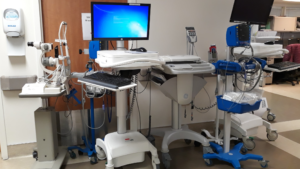
Understanding Your WiFi Network Performance

If we asked you how great your WiFi network performs, how would you respond? A strong “great!”, a shrugged “meh,” or a silent shake of the head? While your answer might be easily summed up with one word, determining network performance itself is a little more complicated. It involves analyzing numerous metrics in order to determine baseline performance and current performance, as well as gathering actionable data to resolve performance issues.
This work is worth it though. Network demands increase every day and many businesses can’t function without a wireless network. Using analytics to determine and evaluate network performance leads to improved end user experience, both for internal employees as well as external customers. This translates to everything from increased sales, to better educational support for students, to improved monitoring for patients in healthcare facilities.
How to Measure
As networks are dynamic, they must be analyzed on a constant and continuous basis. There’s no such thing as optimizing the network at the beginning of the month, and then walking away. The network changes throughout the day and night so nothing can be taken for granted. If not identified proactively, issues can remain undetected for long periods of time before rising up and causing an IT crisis at the worst possible moment. By combining 24/7 monitoring and scheduled network tests, organizations across all industries have access to the insights needed to truly ensure optimal performance.
Rather than trying to manage this analysis manually, we recommend working with an AI-Driven analytics platform. This not only saves IT time, but also improves operational efficiency in a cost-effective manner. As the number of network devices and applications continues to increase, thousands of data packets must be analyzed in real-time every second to manage network performance. It is not possible for humans to ingest and understand that data in a timely manner, but it is possible for automated platforms to do so. Using these platforms frees up IT to focus on other critical responsibilities while supporting quality network performance at all times.
Continuous Analytics
The key to an optimized network is constant visibility into the entire wireless ecosystem. This can be achieved with both passive monitoring and active testing. Here’s what that means.
In a passive mode, an analytics platform is listening only. It is not transmitting data. This allows the platform to retrieve all analytics without adding traffic to the network and increasing demand.
The only time this changes is when the platform needs to run network tests. Network tests should be run on a scheduled basis to capture valuable client and network analytics. To run the tests, the platform will need to connect to the network and actively transmit data. This allows it to test anything from application response times to server performance and everything in between. When finished conducting the tests, the platform should disconnect and return to passively monitoring.
Both modes allow the platform to capture exactly what end user devices are experiencing. As a passive observer gathering analytics, the platform gets an omniscient view of network interactions. Then, as an active tester, the platform gets the chance to connect as an end user device and experience the network firsthand.
Whichever mode it is in, the platform should have enough radios to continuously monitor both the 2.4GHz and 5GHz spectrums. Any switching between the spectrums, or switching from monitoring to another task such as testing, results in lost data. When it comes time to identify performance issues or review trends over time for future capacity planning, the last thing a business wants is missing data.
What to Measure
The short answer is: everything. The platform should provide analytics for not only your network, but the entire radio frequency (RF) environment in which the network operates. This will include any nearby networks sharing the airwaves as well as interference from any non-wireless devices like microwaves or medical equipment. Taken together with network devices and infrastructure, this is what we refer to as the wireless network ecosystem.
The platform should monitor this ecosystem 24/7. If the platform boasts Artificial Intelligence, it should be able to recognize normal network behavior and automatically alert IT if that behavior changes in any way. Additionally, the platform should run scheduled network tests to proactively detect any issues. This includes issues with security, servers, applications, devices, and internet connectivity. Detecting issues proactively enables IT to resolve them before end users are impacted.
Finally, the platform should not only provide analytics in real-time, but should also automatically save historical data for future use. When budget and capacity planning season rolls around, having access to these analytics will provide decision makers with the key intelligence needed to understand how performance has changed over time, what impacted performance, and what upgrades/updates need to be made for the future.
Improving Mean-Time-to-Resolution (MTTR)
When defining performance, you will frequently hear people discuss latency (how quickly data travels from one device to another), data packet loss, and throughput and bandwidth (different ways of measuring how much data can be transmitted in a certain time). While these broad categories do affect end user experience, resolving a performance issue isn’t as simple as saying “latency is too high.” IT must discover exactly why latency is too high. Is network congestion causing an issue? Where? Why? Is there an issue with the Access Points (APs)? What kind of issue? Are only certain devices reporting latency problems? Is latency constantly or intermittently high?
As you can imagine, eliminating options and determining the root cause of the problem can be time-consuming. Unfortunately, IT can’t resolve an issue before they have this root cause. What to do?
A good way to support IT to a quicker MTTR is with constant analytics. This ensures that IT teams always have all the information that they need to identify the root cause of a problem without requiring them to spend time with packet capture.
However, a great way to support IT is with automatically identified root causes and suggested actionable resolutions, a benefit of some analytics platforms. IT teams that receive instant alerts with all this information included are way ahead of the curve and will experience significantly reduced MTTRs. This can mean that the network returns to optimal performance up to 90% faster, which in turn results in an overall decrease in WiFi problem tickets.
Take the Next Step in Network Optimization
Bring WiFi Automation to your organization and let an AI-powered analytics platform handle 24/7 network monitoring. Experience improved end user experiences and operational efficiency with consistently reliable WiFi without blowing your budget through the roof. Optimized network performance at all times is possible. Bring it to your organization today.
To protect your WiFi-dependent business with the best network performance, ask us about our historical analytics and first-to-market WiFi 6 support.

